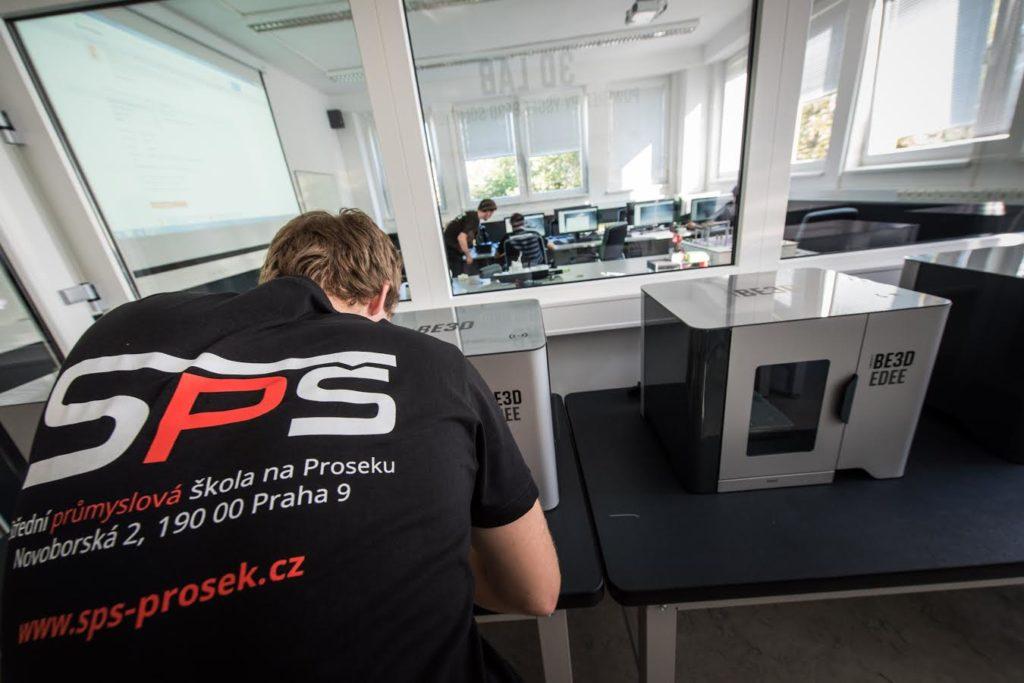Y Soft’s International Education Survey Finds That Majority of Schools Limit Student Access to 3D Printing
![]() It’s a fact that students go to school to learn. They learn about historical events and how the government works, they learn how to perform mathematical equations, and they learn how express what they’ve learned through writing. Not always as often, they learn about music and art, and how to play sports like dodgeball and tennis in gym class (or as I liked to call it, my weekly torture session). Often, students even have the opportunity to learn about new technology, like 3D printing. Many schools, especially those focused on STEAM education, are embracing 3D printing…but maybe not as many as we think. Today, at the education-transforming BETT Show in London, Czech Republic-based technology and office solution provider Y Soft Corporation announced the shocking results of an international survey about 3D printing in the education sector…87% of schools limit students’ access to 3D printing.
It’s a fact that students go to school to learn. They learn about historical events and how the government works, they learn how to perform mathematical equations, and they learn how express what they’ve learned through writing. Not always as often, they learn about music and art, and how to play sports like dodgeball and tennis in gym class (or as I liked to call it, my weekly torture session). Often, students even have the opportunity to learn about new technology, like 3D printing. Many schools, especially those focused on STEAM education, are embracing 3D printing…but maybe not as many as we think. Today, at the education-transforming BETT Show in London, Czech Republic-based technology and office solution provider Y Soft Corporation announced the shocking results of an international survey about 3D printing in the education sector…87% of schools limit students’ access to 3D printing.
 The survey asked owners of 3D printers in education a broad set of questions about their 3D printing use, to learn more about how educators were including the technology in their lessons. When asked why their schools were introducing 3D printing to the classroom, many survey respondents listed creativity, motivation, and use of technology with STEAM subjects as the reasons. Those all seem like solid reasons to let students use 3D printers, so why the limitations? As it turns out, the Y Soft survey indicated that 3D printers currently available on the education market have three main downfalls that cause them to be under-utilized by students:
The survey asked owners of 3D printers in education a broad set of questions about their 3D printing use, to learn more about how educators were including the technology in their lessons. When asked why their schools were introducing 3D printing to the classroom, many survey respondents listed creativity, motivation, and use of technology with STEAM subjects as the reasons. Those all seem like solid reasons to let students use 3D printers, so why the limitations? As it turns out, the Y Soft survey indicated that 3D printers currently available on the education market have three main downfalls that cause them to be under-utilized by students:
- An inability to manage and control access to the 3D printer. This leads to the machines being locked away in rooms that require special access, or are only available during certain hours of the school day. What’s worse, sometimes students even have to request the teacher to 3D print their model, which hinders any learning about how to use it.
- Educators are not able to manage 3D printing time and materials costs in order to allocate classroom/department expenses. Some schools use pay-to-print systems for paper printing, but currently, there are no similar systems available for 3D printers.
- There is a lack of guidance on adding 3D printing to classroom curriculums.
While I don’t know if that last point is true for all schools and 3D printer manufacturers, clearly these are major problems that need to be addressed, as 3D printing in schools continues to rise in importance, for several reasons.
Y Soft CEO Václav Muchna told 3DPrint.com, “Educators, particularly those who teach STEM subjects, want to ensure that students are prepared with the skills they’ll need in the workplace. Tools, such as 3D printers that aid in student’s ability to learn complex concepts in an engaging and motivating fashion, are proven to be welcomed additions in the classroom. 3D printers also enable students to be creative and, for today’s students, that is important.”
The results of this survey were consistent with Y Soft’s one-year 3D printing classroom study, conducted with a secondary technical school in Prague. As a result of what the company learned from this study, Y Soft worked to enhance its desktop 3D printer in order to address the specified difficulties with accounting needs, authorized access, and print management in its flagship education 3D print management solution, YSoft be3D eDee. The company has also held inspiring teacher workshops that shows teachers how 3D printing can incorporate multiple other classroom subjects.
“The YSoft be3D eDee solution is a 3D printer so that is one thing,” said Muchna, when asked how the Y Soft platform was seeking to aid in education. “But where we go beyond other 3D printers is that we have integrated software that allows the school to manage and control student access and costs – just like they do with paper printers today. This means they don’t have to restrict access. And when students have unrestricted access, they can create and be more engaged with the classroom curriculum…and motivated students make educators happy too.”
The survey, conducted by Dimensional Research in November 2016, did show some encouraging statistics on the positive, continued growth of 3D printing in education. Even though there is not a full solution, and an inability to justify ROI (90%), 77% of the educators surveyed indicated that they intend to increase their purchase of 3D printers. Also, while 3D printing is most often used in STEM subjects, 45% of survey respondents said that they let their students utilize the technology in other areas as well. 3D printing is mostly used in higher education, such as university research institutions (55%), because no mandate exists yet as to how teachers should include 3D printing in lower education. But, 23% of educators surveyed said they do introduce the technology in elementary schools.
 You can take a look at the global survey result highlights in a 3D Printing in Education Report Card; the full survey report is available as a download on the Y Soft website. In the survey results, Y Soft gave both educators and 3D printer manufacturers a Pass, Needs Improvement, or Fail grade. While at the BETT Show this week, Y Soft will also be showcasing its YSoft be3D eDee 3D printing management solution, along with its partner, Tablet Academy. Tablet Academy will also be offering a series of 3D printing workshops, held by Y Soft.
You can take a look at the global survey result highlights in a 3D Printing in Education Report Card; the full survey report is available as a download on the Y Soft website. In the survey results, Y Soft gave both educators and 3D printer manufacturers a Pass, Needs Improvement, or Fail grade. While at the BETT Show this week, Y Soft will also be showcasing its YSoft be3D eDee 3D printing management solution, along with its partner, Tablet Academy. Tablet Academy will also be offering a series of 3D printing workshops, held by Y Soft.
“Educational institutions are challenged to prepare young people for jobs that don’t even exist yet,” said Mark Yorke, Managing Director, Tablet Academy Ltd. “3D printing will certainly form part of the technological advancements happening across the world so providing educators with the opportunity to experience and understand this emerging technology can only be a positive move for all involved.”
Discuss in the Y Soft forum at 3DPB.com.
Subscribe to Our Email Newsletter
Stay up-to-date on all the latest news from the 3D printing industry and receive information and offers from third party vendors.
You May Also Like
HP & INDO-MIM Collaborate to Boost Metal 3D Printing in India
HP Inc. and INDO-MIM, a US- and India-based supplier of metal injection molding (MIM) powders and contract manufacturer, have announced that the two companies will collaborate to accelerate additive manufacturing...
New Report: Semiconductor Industry to See $1.4B in 3D Printing Revenues by 2032
“The semiconductor sector has become the most strategically significant area of global industry.” Truer words are hard to come by when it comes to the modern world, and they are...
One of US’s Largest Machine Tool Resellers to Offer Stratasys 3D Printing
In a key move for the additive manufacturing (AM) stalwart, Stratasys (Nasdaq: SSYS) has announced a strategic partnership with Select Additive Technologies, a division of Morris Group, Inc., which is...
3D Printing Unpeeled: Orbex Investment, IndoMIM and HP, Ultrasonic Waves
INDO-MIM has bought three HP Metal Jet S100 printers, operating two in India and one in Texas. This is a win for HP because the company has deep experience in...






























